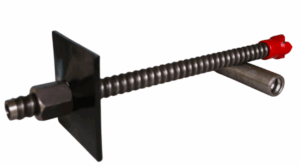Ground screw anchors are transforming how we approach foundations and anchoring systems in construction, landscaping, and renewable energy. Designed to be installed without excavation or concrete, these helical steel anchors offer a fast, stable, and environmentally friendly alternative to traditional footings.
Whether you’re building a deck, installing a fence, or supporting solar panels, ground screw anchors provide a reliable and reusable solution that adapts to a wide range of soil conditions.
Table of Contents
ToggleWhat Is a Ground Screw Anchor?
A ground screw anchor is a steel shaft with helical threads (like a giant screw) that is driven into the ground to provide structural support. The design allows it to displace soil as it’s installed, creating a secure hold without the need for digging or pouring concrete.
Key features include:
- Helical or spiral threads for soil engagement
- Galvanized or coated steel for corrosion resistance
- Hollow or solid shafts depending on load requirements
- Compatibility with various mounting brackets or posts
Practical Applications
Ground screw anchors are used across many industries and project types:
Residential Construction
- Deck footings
- Pergolas and gazebos
- Fencing and gates
- Tiny homes and modular buildings
Commercial and Industrial Projects
- Temporary structures and event tents
- Signage and billboards
- Walkways and boardwalks
- Modular office units
Renewable Energy
- Ground-mounted solar panel systems
- Wind turbine bases
- EV charging station supports
Landscaping and Agriculture
- Greenhouses and raised beds
- Animal enclosures
- Retaining walls and erosion control
Advantages of Ground Screw Anchors
- No excavation required: Saves time and labor, especially in tight or sensitive areas.
- Immediate load-bearing: Unlike concrete, which needs curing time, ground screws can be loaded right after installation.
- Reusable and removable: Ideal for temporary structures or future site changes.
- Minimal environmental impact: Preserves soil structure and vegetation.
- All-weather installation: Can be installed in wet, frozen, or rocky ground.
Installation Process: Step-by-Step
- Site Assessment Evaluate soil type, load requirements, and anchor spacing. Most ground screws work well in clay, sand, gravel, and even bedrock with the right equipment.
- Marking and Positioning Use a layout plan to mark anchor locations. Ensure alignment for structural consistency.
- Driving the Anchor Use a manual bar, impact wrench, or hydraulic driver to screw the anchor into the ground. Maintain vertical alignment and monitor torque to ensure proper embedment.
- Mounting the Structure Attach brackets, posts, or frames to the anchor head using bolts or clamps. Some systems offer adjustable heads for leveling.
- Inspection and Load Testing (if required) For critical applications, perform pull-out or compression tests to verify holding capacity.
Tips for Effective Use
- Choose the right size: Anchor length and diameter should match the expected load and soil conditions.
- Use torque indicators: Helps confirm that the anchor has reached sufficient resistance.
- Avoid over-torquing: Excessive force can damage threads or reduce holding strength.
- Consider frost depth: In cold climates, install below the frost line to prevent heaving.
Limitations to Keep in Mind
While versatile, ground screw anchors may not be ideal for:
- Highly organic or loose peat soils: May require deeper or specialized anchors.
- Heavy vertical loads without lateral support: Additional bracing may be needed.
- Areas with underground utilities: Always perform a utility locate before installation.
Final Thoughts
Ground screw anchors offer a practical, efficient, and sustainable alternative to traditional foundations. Their ease of installation, adaptability, and reusability make them an excellent choice for both permanent and temporary structures.
Whether you’re a contractor, landscaper, or DIY enthusiast, understanding how to select and install ground screw anchors can save time, reduce costs, and improve project outcomes.
0

